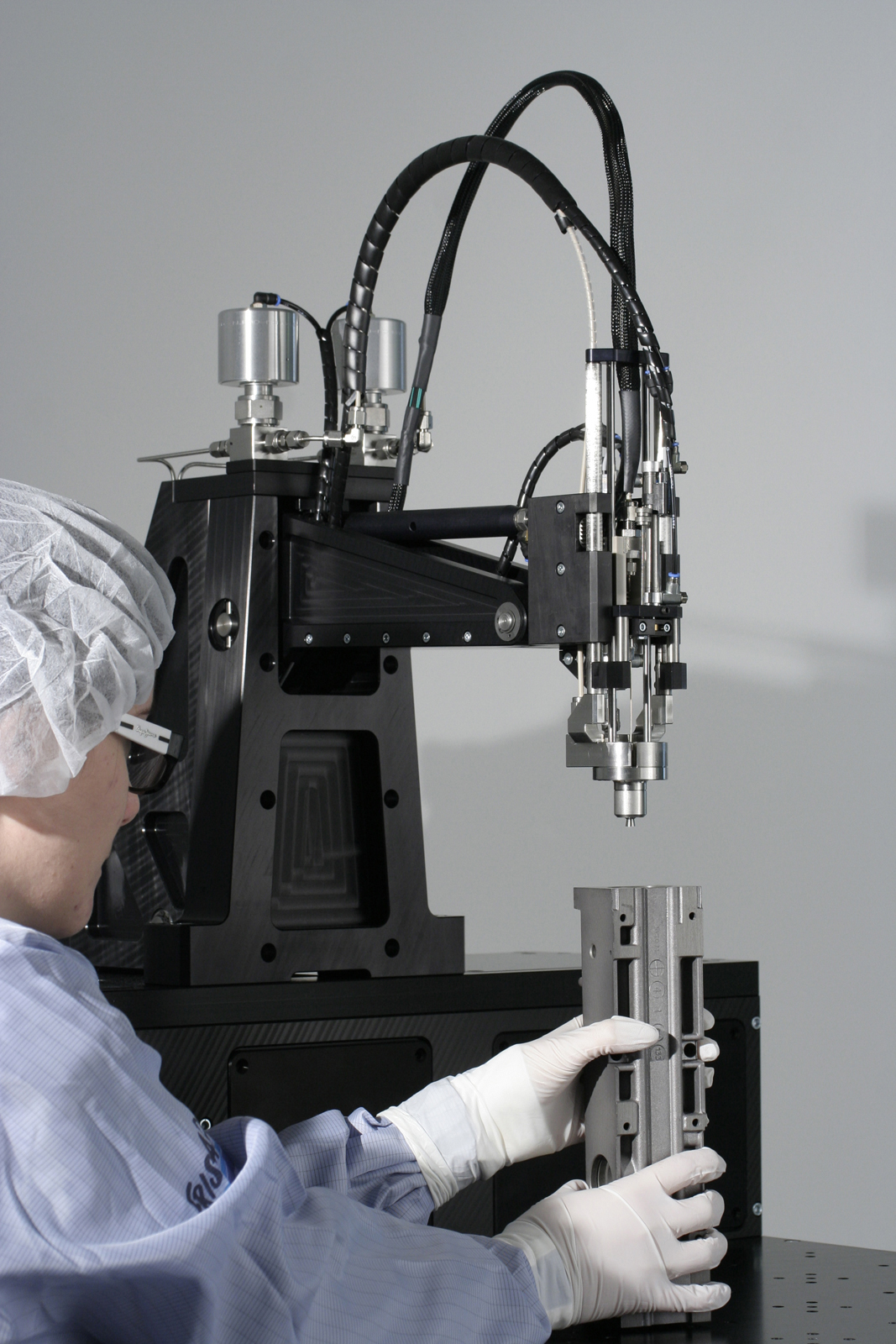Deep cleaning with carbon dioxide
The Fraunhofer Cleaning Technology Alliance FAR is celebrating its 10th birthday at the parts2clean trade fair in Stuttgart, from 23 to 25 October 2012 in Hall 1, Booth F610/G707. To mark the occasion, FAR will be presenting highlights from 10 years of the Fraunhofer alliance, along with the latest concepts, technologies, and test procedures for component cleaning and analysis techniques that can be integrated into the production process. One of the many interesting items on show is a tool that combines – in one step – cleaning with supercritical carbon dioxide and cleaning with CO2 snow.

In server components, hard disks, or clock mechanisms, the smallest impurities lead to malfunctions and short circuits; in optical components such as lenses, they impair quality because they scatter light; in threaded holes, they cause mechanical failure. The phenomena of progressive miniaturization and ever more complex components are presenting the manufacturers of cleaning technologies and tools with big challenges. However, cleaning with carbon dioxide (CO2) has proven itself an effective means of removing extremely fine dirt particles.
At the Fraunhofer Cleaning Technology Alliance booth, the Fraunhofer Institute for Manufacturing Engineering and Automation IPA is presenting a tool capable of completely removing processing residues from areas inside components that are difficult to clean, for example blind holes and boreholes. The tool was developed in the DeepClean collaborative project, where IPA researchers successfully combined different CO2 cleaning techniques in a single cleaning step: degreasing with supercritical CO2 and removing particles with CO2 snow crystals. “At a pressure from 74 bar upward and a temperature of 31 degrees Celsius, carbon dioxide changes into a new state, becoming supercritical. In this state, it absorbs foreign matter such as oils and greases,” explains IPA engineer Dr. Markus Rochowicz. Fitting the tool over the borehole hermetically seals the inside of the component. Then it is rinsed and degreased with supercritical CO2. When the cleaning tool is opened in the second stage of the process, CO2 snow is produced, and this removes particles from the component. The force of the CO2 snow crystals generated in the nozzle of the cleaning tool is so great that even the tiniest particles can be efficiently removed without damaging the cleaned surfaces. As the CO2 changes back from a solid to a gaseous state immediately after the cleaning, i.e. the snow crystals evaporate, the cleaned component stays completely dry – an advantage with moisture-sensitive materials.
Cleaning laboratory open to outsiders for carrying out tests
The compact size of the cleaning nozzles not only means that the tool is suitable for manually cleaning components, it can also be integrated into very tight spaces in fully-automated assembly procedures – for example in the auto industry, where it can be used to remove residues from the hydraulic system, the ABS, or the distribution block during the production process. The innovative tool also has benefits for other sectors: in medical engineering, for instance, where it can be used to clean endoscopes, cannulae, and the bases of dental implants. “The exhibit should also interest manufacturers from the semiconductor, pharmaceutical, optical goods, and aerospace sectors,” anticipates Rochowicz. After the trade fair, the system will be available to companies for industrial cleaning tests in the IPA’s highly specialized CO2 cleaning and analysis laboratories. The European Space Agency (ESA) has already used the laboratory infrastructure to look into ways of ensuring the absolute cleanliness of components for future missions to Mars.
Fraunhofer Cleaning Technology Alliance turns 10
Cleaning with carbon dioxide is just one area in which the Fraunhofer Cleaning Technology Alliance (http://www.allianz-reinigungstechnik.de/en.html) has greatly expanded its research activities over the past few years. FAR members (see the list below) have also become heavily involved in atmospheric-pressure plasma, laser procedures, cleanliness testing, purity assessment, surface analysis, and failure analysis – to name just a few areas – over the ten years of its existence. “The expertise in the individual institutes covers the whole length of the cleaning technology process chain as well as the upstream and downstream process steps,” says Martin Bilz, spokesperson for the Fraunhofer Cleaning Technology Alliance and engineer at the Fraunhofer Institute for Production Systems and Design Technology IPK in Berlin. At this year’s parts2clean trade fair, FAR will be exhibiting a large variety of methods and tools for a wide range of cleaning operations in many different industrial sectors. The Cleaning Technology Alliance will be celebrating its birthday at its traditional trade fair party on Wednesday, October 24 from 5:30 p.m. (Hall 1, Booth F610/G707).
In 2007, FAR conducted a “Market and trend analysis on industrial cleaning of components” for the first time, a project it will undertake again for its 10th birthday. “We expect to publish the study in spring 2013,” says Bilz. Building on the first study, FAR organized a cleaning technology seminar on the basic principles of cleaning in production in 2009 for the first time. This seminar has gone on to become an annual event. In this anniversary year, the seminar has been included as a course within the Fraunhofer Academy’s training program.
FAR members
• Fraunhofer Institute for Production Systems and Design Technology IPK
• Fraunhofer Institute for Interfacial Engineering and Biotechnology IGB
• Fraunhofer Institute for Electron Beam and Plasma Technology FEP
• Fraunhofer Institute for Laser Technology ILT
• Fraunhofer Institute for Surface Engineering and Thin Films IST
• Fraunhofer Institute for Manufacturing Engineering and Automation IPA
• Fraunhofer Institute for Material and Beam Technology IWS
• Fraunhofer Institute for Manufacturing Technology and Advanced Materials IFAM